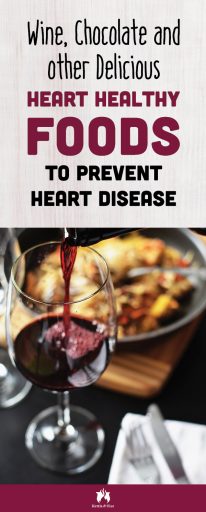Wine, Chocolate, and other Delicious Heart Healthy Foods To Prevent Heart Disease

It shouldn’t be a challenge to find heart-healthy foods to nourish our bodies. We know we should eat more fruits and vegetables for just about every type of healthy diet, but it can feel difficult to make the right choices. We hope to clear away the confusion by first identifying what to avoid and why and then sharing the best heart healthy foods to eat for a strong ticker.
The S.A.D. Problem
S.A.D. is an acronym for Standard American Diet. It describes a style of eating that a large percentage of Americans follow. It includes processed foods (such as lunch meats), refined grains, trans fats, fast food, sugar-sweetened beverages and boxed snack foods. These foods tend to be chock-full of sugar, fat and salt. They’re also devoid of important micronutrients and beneficial fiber to aid in digestion and feed healthy bacteria in the gut. In essence, they’re empty calories that do nothing to boost your health and well-being.
The S.A.D. is an appropriate double entendre, because it bears a direct responsibility for the sad epidemic of preventable lifestyle diseases, such as cardiovascular disease, diabetes, metabolic syndrome, neurodegenerative disease and even some cancers in our country. (1)
According to the American Heart Association, cardiovascular disease (which includes heart disease and stroke) is the underlying cause of death for one in three Americans. Additionally, nearly 10 percent of American adults have a Type 2 diabetes diagnosis. (2) Oftentimes, patients are facing both of these diseases at once, as diabetes is a significant risk factor for cardiovascular disease. (3) These statistics are staggering, especially considering the important role lifestyle plays in prevention.
Prevention of Heart Disease
Instead of waiting for signs of a problem — such as high blood pressure or high cholesterol levels — to motivate you to change your diet and lifestyle, start taking steps toward prevention of cardiovascular disease now. Making small changes over time can add up to major shifts in your overall health and protect your organs and blood vessels from the serious damage that a poor diet and a sedentary lifestyle can cause.
For both heart disease and diabetes, the prevention strategy is the same because many of the risk factors for these two diseases are the same: obesity, high LDL cholesterol and low HDL cholesterol, sedentary lifestyle and the S.A.D.
Lifestyle adjustments, such as quitting smoking, exercising for at least 30 minutes a day and reducing stress, are critical pieces of the prevention puzzle. But the final and arguably most challenging piece of the puzzle is following a heart-healthy diet.
Heart Healthy Foods
When it comes to a heart-healthy diet, reducing chronic inflammation is essential. Studies show that chronic inflammation, even at subclinical levels, is a significant risk factor in all lifestyle diseases. (4, 5, 6) Choosing foods that reduce inflammation and minimizing those that increase it (namely just about everything in the S.A.D.) are two of the best things you can do for your health and longevity.
Plant foods that are rich in flavonoids have been shown to offer protection against cardiovascular disease and cancer through a number of biological functions. (1, 10, 11) Flavonoids include a number of important antioxidant compounds, such as anthocyanins and isoflavones, all of which play a role in protecting us from a host of diseases. Tannins, triterpenoids, procyanidins and polyphenols are other examples of protective compounds found in colorful plant foods — especially green leafy vegetables — and beverages like wine, tea and coffee. We’ve created a list of foods jam-packed with the nutrients you need to maintain a heart-healthy diet.
Bone Broth
Because bone broth cooks down slowly, extracting vital components of the bone matrix into the liquid, it offers a host of heart-healthy nutrients. Minerals and electrolytes such as calcium, magnesium, potassium, phosphorus, amino acids and collagen are all extracted into a golden elixir that fights inflammation and supports healthy vascular and digestive function. (9) The slow-cooking process allows for easier absorption of the compounds, making bone broth an ideal way to consume these nutrients. (You can find it in stores or make it at home in your slow cooker!)
Turmeric
An Indian spice most notable for its golden-yellow color, turmeric is a key ingredient to many curry dishes. It’s also an important Ayurvedic medicinal herb used orally, topically and as an inhalant. The active anti-inflammatory ingredient in turmeric is curcumin, which actually inhibits molecules that play a role in setting off an inflammatory response in the body. (7)
Fresh turmeric looks a lot like ginger — in fact, they’re in the same plant family — and can be used in soups, stews and homemade curry. Golden milk, a delicious hot drink that features coconut milk, ground turmeric and other spices, is a newly popular way to get a regular dose of turmeric into your life. Juicing the fresh root as a complement to other fresh veggie juice works great as well. Check out our Bone Broth Sipping Guide to learn more ways to incorporate bone broth and turmeric into your daily routine. If you’re not a fan of the flavor, you can purchase turmeric as a supplement in most health food stores.
Omega-3 Fatty Acids
Omega-3 fatty acids (a type of polyunsaturated fat) are also anti-inflammatory. They work in the body to reduce inflammation through a number of biological actions, one of which inhibits the formation of arachidonic acid. Arachidonic acid has a pro-inflammatory purpose in the body, activating our immune system to protect us. It’s derived from another type of polyunsaturated fat, omega-6 fatty acids.
The ideal ratio of omega-3 to omega-6 fatty acids — both of which are found in the most common cooking oils (canola oil, safflower oil, vegetable oil, soybean oil) and junk food — is equal consumption of both. In the S.A.D., however, we over-consume foods rich in omega-6, thereby putting too much inflammatory arachidonic acid into our bodies and creating inflammation. Choosing foods rich in omega-3 fatty acids to balance things out will reduce inflammation and improve heart health for just about everyone. (8)
You can find omega-3s in foods such as:
- Walnuts
- Flax seeds
- Chia seeds
- Ocean algae, and in the fish that eat the ocean algae
- Wild-caught small fish such as sardines and anchovies
- Wild-caught salmon and other large, fatty fish
Ideally, we recommend focusing on the smaller fish rather than over-consuming salmon, because the larger the fish, the greater risk you have of consuming ocean pollution, such as microplastics and mercury.
Berries, Grapes and Red Wine
Anthocyanins are responsible for the red, blue and purple color of foods such as berries, beets and grapes. Along with a host of other plant compounds also present in these richly colored foods, anthocyanins have been shown to protect against certain cancers, neurodegenerative diseases of aging, and vascular diseases such as atherosclerosis and ischemic stroke. (10) In addition to offering these protective compounds, berries have a healthy fiber to sugar ratio, which means they won’t spike your blood sugar.
Tea, Coffee and Dark Chocolate
Tea (black, green and white), coffee and dark chocolate have more in common than offering a little pick-me-up. They are also rich in antioxidant flavonoids, specifically polyphenols and procyanidins. Much like anthocyanins, these compounds protect the vascular system, support healthy cholesterol levels and impede the inflammatory process that harms the heart. (12, 13 )
Other Fruits and Veggies
In addition to the colorful and delicious categories of foods and beverages we’ve already mentioned, green leafy vegetables (romaine, chard, kale), brassicas (broccoli, kale, cauliflower, brussels sprouts), alliums (onions, garlic, scallions), citrus fruits (lemons, limes, oranges, grapefruit) and legumes (beans and lentils) all have their own protective power against oxidative stress, a risk factor in heart disease. (7, 14)
Getting a variety of colorful fruits and veggies onto your plate every day will ensure that you’ve covered your bases and consumed adequate protective antioxidants. Topping your salad with extra virgin olive oil or adding a bit of bone broth to your homemade salad dressing will also add some nutritional umph to your daily diet.
5 Simple Heart-Healthy Tricks to Remember
Eat the Rainbow
Managing your diet can be a lot easier than managing a medicine cabinet if you follow this simple rule. The heart-healthy foods we’ve listed above represent every color of the rainbow. Keep the rainbow in mind as you push your shopping cart through the produce section.
Shop the Perimeter of the Grocery Store
The heart-healthy foods you’re looking for live in the produce section and the fresh meat and fish counters at your local market. The center aisles contain very little heart-healthy foods. If you skip the chips and drink aisles, you’re already making big headway.
Cook Light
We don’t necessarily mean low fat when we talk about cooking light. We just mean to prepare your veggies so that they’re only lightly cooked. Try steaming and topping them with olive oil after the cooking process is over in order to preserve all the nutrients in both the veggies and the olive oil. High heat can damage the most nutritious elements of your meal.
Talk to Your Waiter
We know that there’s not always time to prepare every meal. When you go to a restaurant, advocate for your own health by talking to your waiter about what you want to eat. Don’t be afraid to ask about the unlisted ingredients on the menu or whether the fish is wild-caught. When possible, choose olive oil and vinegar for your salad dressing instead of a bottled dressing, which is often laden with hidden sugars.
Find a Friend
Sticking to health goals is much easier if you have someone to talk to and share meals with. Ask your roommate or spouse to help you out by letting you cook for them or by joining you for a heart-healthy restaurant meal. Having support is a big key to success when making any kind of lifestyle adjustments.

If you liked this article, you might like:









